We’ll be following the next three science verification cruises beginning in early May.
We’ll be following the next three science verification cruises beginning in early May.

R/V Neil Armstrong enters San Francisco Harbor in November 2015. (Image by Bay Aerial ©Woods Hole Oceanographic Institution)
With Neil Armstrong scheduled to arrive in Woods Hole at 10:00 a.m. Wednesday, we thought it would be a good time to quickly catch up on news from the ship. Read More →
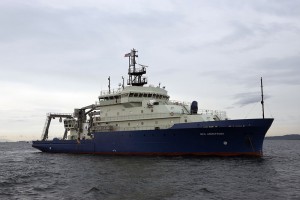
R/V Neil Armstrong at anchor waiting for its turn to enter the Panama Canal from the Pacific Ocean side. (Photo by Chris Linder, WHOI)
The Panama Canal is described as one of the engineering wonders of the world. Never having seen it, I jumped at the chance to sail its length aboard the newly built research vessel Neil Armstrong during the ship’s inaugural voyage from the West Coast to Charleston, N.C., and eventually to its home port on Cape Cod at the Woods Hole Oceanographic Institution (WHOI), where I am a member of the Corporation.
We few like-minded zealots for the spectacle of a new ship with an iconic name transiting between oceans flew to a waterfront hotel on the Pacific side of the Canal two days before the ship arrived. Five of us had sailed together a few years earlier on a trip to hike the penguin and seal colony shores of South Georgia Island for a week, so it was also a bit of a reunion.
On the morning of the lay day we toured a Smithsonian biological research station on a small island connected to the city by a hundred year-old causeway made of tailings from canal dredging. This and several nearby islands were armed with heavy artillery during the two world wars to defend against naval attacks on the Canal that never materialized.
In the afternoon, we visited the observation platform and museum at the Miraflores Locks—the “uphill” locks on the Pacific side that raise ships to nearly the level of the manmade Lake Gatun that constitutes the major passageway across the 45-mile-wide isthmus.
The next day, the ship’s agent provided a van that took us to a dock from which a launch ferried us to the ship anchored among several dozen other, mostly larger ships also awaiting their pilots and assigned transit times.
The rain held off on the Pacific side, but our schedule slipped until we ended up making the transit at night. Fortunately, the lighting at the locks was enough to provide great views and the allowed WHOI photographer Chris Linder to capture our progress through the first two locks.
It amazed me to see these big locks, built by the US Army Corps of Engineers 100 years ago, in such fine shape. They were and still are powered mostly by electricity, but if you look closely at the time lapse sequence, you can see one thing that has not changed—two men in a rowboat is still best way to get a line from the ship to the electric tugs (originally built by GE) that pulled us through.
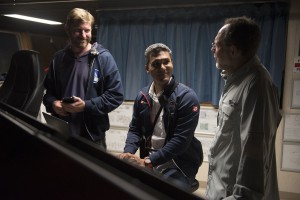
Kent Sheasley, captain of <i?Neil Armstrong; our Panama Canal pilot; and Rob Munier, director of WHOI Marine Operations. (Photo by Chris Linder, WHOI)
Today, the existing locks are too small for the growing number of huge container ships that haul cargo between markets in Asia, North America, and Europe, so Panama is building a third set of locks nearby that will be 50 percent larger than the existing 110-by-1050-foot locks. These are scheduled to open in 2016. Some, however, question the economics of this major new investment—and there is a persistent but diminishing threat of a Chinese-funded canal across Nicaragua.
It was a great trip that was enormously enriched by my contemporaneous reading of David McCullough’s Path Between the Seas, which documents in vivid detail the trials and failures of post-Suez efforts by the French in the late 1800s, as well as the agonizing political difficulties that occurred in Washington before Teddy Roosevelt finally settled on the Panama location for a canal between the oceans against the wishes of interests who favored Nicaragua. While the engineering were, indeed, herculean, it was the conquest of yellow fever and malaria that actually allowed the Canal to be completed—mostly using labor from the West Indies, not Panama. The public health achievements were and are largely unsung, but were every bit as dramatic as the blasting, digging and dredging that gave the Canal its final form.
In one of the oddest quirks of geography, we actually had to travel west through the Panama Canal to get from the Pacific to the Atlantic, and at daylight we exited the Canal through the Gatun Locks into Limon Bay on the Atlantic side. A group of us disembarked in the rain and traveled by launch and van back to the airport through morning rush hour in downtown Panama City. From there, most of us flew back to our respective homes on Thanksgiving Eve.
In all, Neil Armstrong is a fine ship with an amazingly capable and dedicated crew. I am confident that under WHOI’s experienced stewardship, it will serve the ocean research community—and the nation—well for many decades.
It was a spellbinding first week at sea. The weather’s been warm and the ocean has been calm as we continue our journey south. The first few days coincided with the new moon, which created ideal conditions for stargazing. It has been interesting to follow our progress on Earth by observing the night sky. As we advance toward the equator, Polaris descends, dropping closer to the horizon every night. At the same time, more southerly constellations have made themselves visible, illustrating new sagas in the sky. What a wonderful way to gain fresh perspective on our place in the solar system!
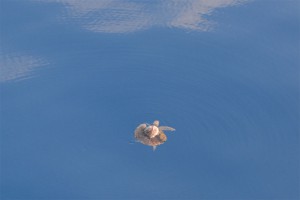
A green sea turtle swims through a calm ocean. (Photo by Kali Armstrong, Woods Hole Oceanographic Institution)
There is plenty to observe during the day, as well. The sun’s rising and setting over the ocean has been breathtaking. The sea surface reflects all the dreamy colors of the sky like a liquid mosaic. Wildlife is abundant in these warm, tropical waters and I have been very fortunate to identify a new species every day. Pacific spotted dolphins have been seen most often and make the most wonderful company. It is such a joy to watch them leaping alongside in the waves made by the ship. Just a day or so ago, we watched an entire pod excitedly feast on a bait ball of smaller fish. In addition to dolphins, tuna and myriad birds participated in the smorgasbord. Ecology at its finest!
Sea turtles–green and loggerhead–have been a delight to observe, lazily floating along the sea surface. Every now and then, you’ll catch a booby bird hitching a ride on a turtles’ shell. (One has to wonder if they’ve somehow been given permission.) There are four species of booby in the tropical Pacific. Possibly the most popular is the blue-footed booby, known for nesting on the Galapagos Islands. However, red-footed, brown and masked boobys all flourish here, as well. Watching them in hot pursuit of scattering flying fish is quite the sight as their razor-sharp wings etch through the air with precision and ease.
It is intoxicating to imagine what wonders the Atlantic Ocean will hold!
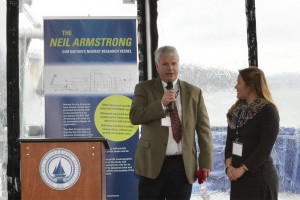
Neil Armstrong’s son Mark and granddaughter Kali address the audience in San Francisco during an event to introduce the ship to visitors during a stopover on its inaugural voyage.
[Editor’s note: We are very pleased to have Kali Armstrong, granddaughter of Neil Armstrong, traveling with us from San Francisco to Charleston aboard on the ship bearing her grandfather’s name. She will make periodic contributions to the blog. This is her first entry—and her first sea voyage.]
Dawn breaks over the ocean like a watercolor dream. Colors flood the surface of the sea in dazzling displays of sparkling light. A rosy sun rises to greet the Northern Hemisphere with a joyous day as a cool, blue Earth rotates on its axis to welcome the warmth.
Out here in the wide-open ocean, it’s not as difficult to imagine this blue planet, twisting and orbiting in its rhythm among the vast celestial bodies of elements and gas. Taking to the sea for the first time is like opening your eyes to a world you’d forgotten existed. You read about the sea in epics and poems; you admire its beauty in paintings and hear tales of beasts and long-lost plunder. But you can’t possibly fathom its full depth until you’ve set sail on this watery kingdom.
You stretch your imagination as far as possible, and then the sea stretches it further.
In the short time I have been sailing on this research vessel, I have gained a wealth of experience. My perspective of life on Earth has enhanced, my notions of environmental conservation have greatly deepened, and my sense of being has been renewed. This is where life all started—a here in the briny depths of this aqueous realm. The environment is all so foreign, yet so strangely familiar. As if the cells in your body realize something you do not. Home. A home away from the home you have created. An internal ticking as old as time itself.
The sea is a place for discovery. It holds more answers to the world’s problems than we could begin to understand. But we want to understand! We seek those answers here aboard the R/V Neil Armstrong. She’s a vessel with a heart of steel and a mission to expand the bounds of knowledge. The research to be done on this ship will change life as we know it—expanding our understanding of this planet and our place within it for generations to come. All of that begins with a capable ship and a passionate crew.
The incredible people aboard this vessel operate by the laws of the sea. They appreciate the planet as a whole, functioning organism—interpreting winds, currents, weather and stars—all while operating an extremely complex machine amidst the elements. These are people with a more complete comprehension of what it takes to thrive in a changing planet. The objectives are straightforward—seek, explore, discover, expand, evolve—but the journey is arduous. It humbles me to the point of speechlessness to be a part of this quest for discovery, but I’ll do my best over the next couple weeks to share my experience. I hope you will continue to check in with the crew of this pioneering vessel to see what the ocean may offer you.
We arrived in San Francisco on November 7 to an unusual sight: clear skies, calm seas, and very little ship traffic. It was so calm, in fact, that I woke up in a panic thinking that I’d missed our passage through the Golden Gate and that we’d already docked. But when I checked my watch, it was 5:30 a.m. Sleep was going to be impossible with all the adrenaline still pumping through my veins, so I got dressed, skipped coffee in the mess, and went out on deck to watch the sun come up.
Aside from sailing under one of the most iconic bridges in the world, the passage into San Francisco Harbor was uneventful. Memorable, stunning, and beautiful, but uneventful. We nudged up to the pier just south of the Bay Bridge, passed our lines to a few helping hands on shore, and suddenly the inaugural voyage of R/V Neil Armstrong was over.
Video by Bay Aerial ©Woods Hole Oceanographic Institution
The rest of our time in San Francisco was occupied with either getting the ship ready to host a parade of guests or watching the faces of our guests beam as they looked out from the bridge over the waterfront or stood on deck and listened to the crew describe science at sea.
As commonplace and everyday that life aboard a ship can quickly become, all it takes is a handful of visitors to remind us that there really is something romantic and other worldly about a ship, especially a research vessel. Even if that ship is functional and business-like, as this one is, the Neil Armstrong radiates a sense that its job is special. Add that special name to the bow and put “R/V” in front of it and you can understand why four pilots came out to guide us in, why more then 100 people streamed up the gangplank on Sunday and a rainy Monday and left only grudgingly, and why watching the video of us steaming under that bridge still brings chills.
There’s something about this ship
This weekend, the Neil Armstrong will be dropping anchor in the approach to the Panama Canal, where it will await a new group of visitors—and its turn to pass through to the Caribbean. After that, it will turn north for Charleston, S.C., and another shipyard, where it will receive much of its science equipment and truly become a research ship. Our work with the cranes and winches and our time living on board also revealed some small changes that could help make the ship even more workable and livable.
After shakedown cruises and tests of its new systems, Neil Armstrong will begin a series of science verification cruises in early March designed to assess the ship’s ability to support the full range of oceanographic work that will form its mission for decades to come. After that, or actually in the middle of all that, the ship will make its way north.
It’s not every day that an institution like WHOI gets to welcome the arrival of a new ship. In fact, it’s quite rare, so it will almost certainly be an exciting time in Woods Hole when the ship rounds Naushon Island and makes its approach to the WHOI dock that first time. Probably even more exciting than the trip into San Francisco.
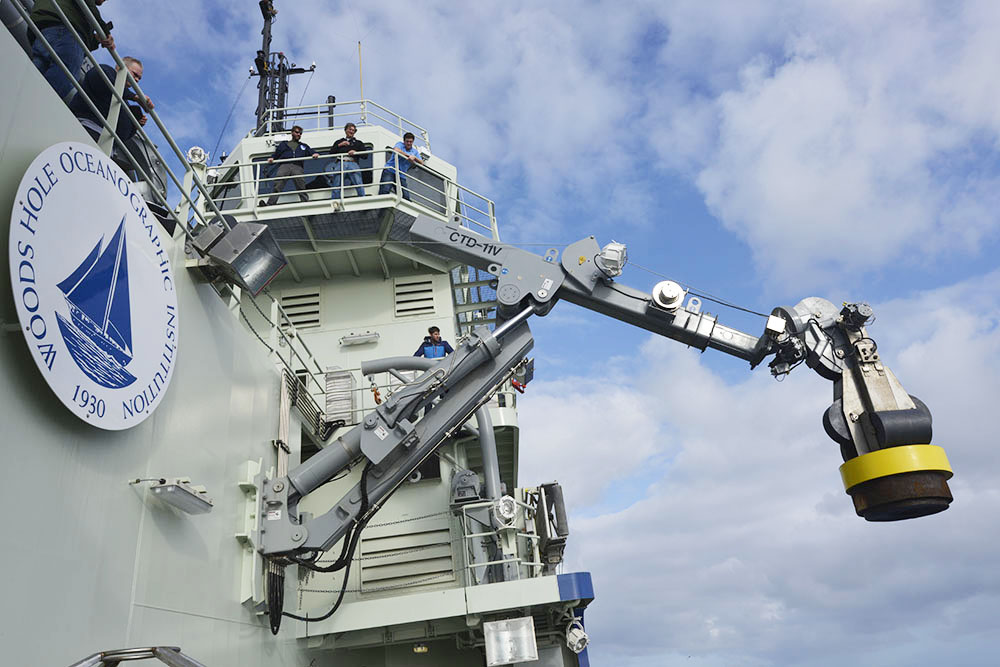
The first test of the CTD knuckleboom with an iron weight drew a crowd to the catwalks. (Photo by Ken Kostel, Woods Hole Oceanographic Institution)
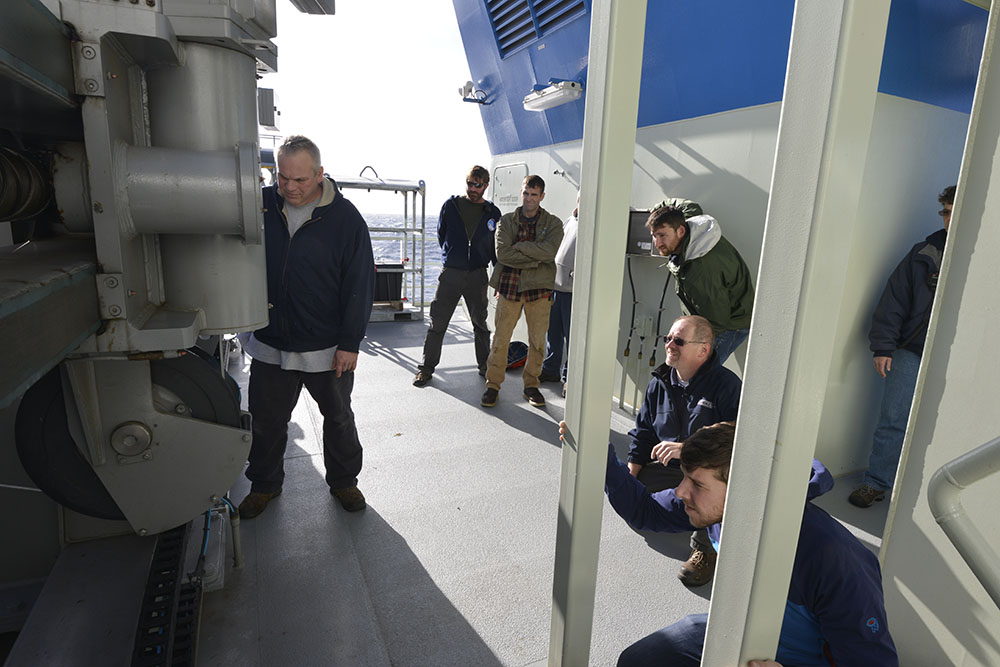
The operation of the level wind also drew a crowd. (Photo by Ken Kostel, Woods Hole Oceanographic Institution)
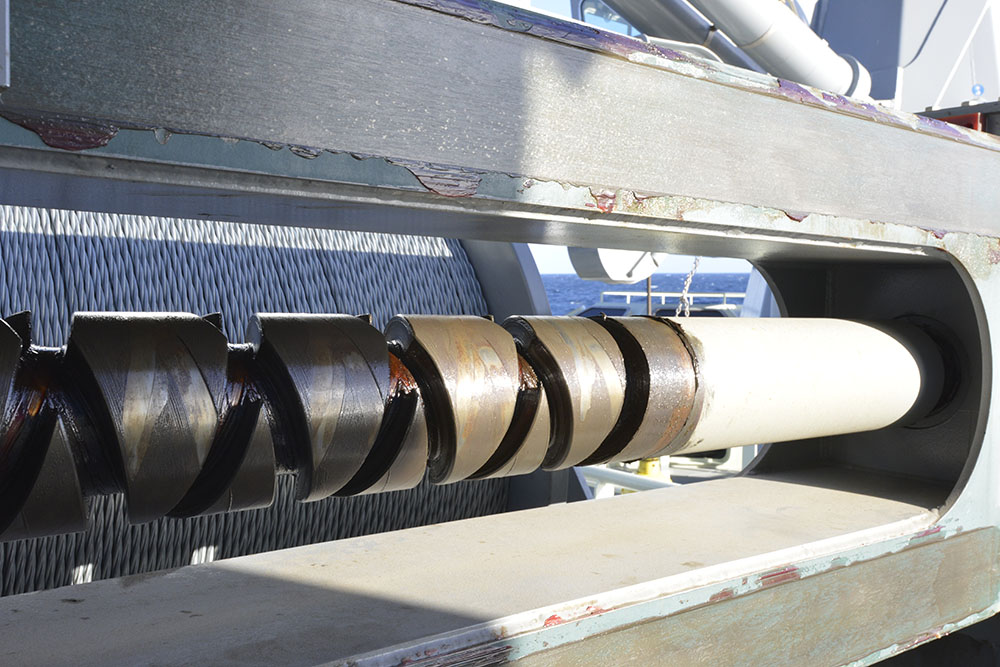
The diamond screw on the level wind of the winch holding 10 kilometers (6 miles) of 3/8" wire. (Photo by Ken Kostel, Woods Hole Oceanographic Institution)
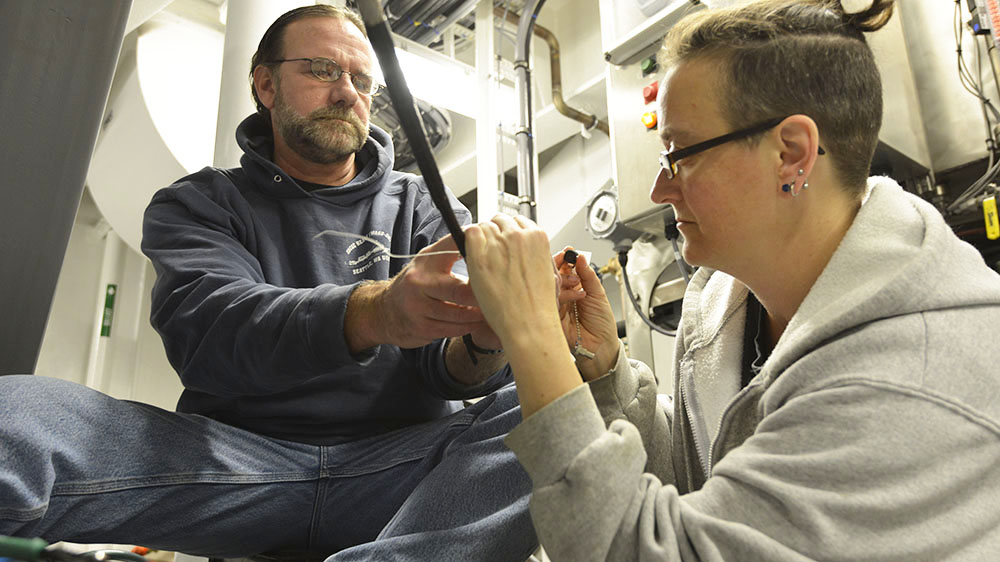
Chris Griner and Amy Simoneau test one of the three optical fibers at the center of the .681 cable. (Photo by Ken Kostel, Woods Hole Oceanographic Institution)
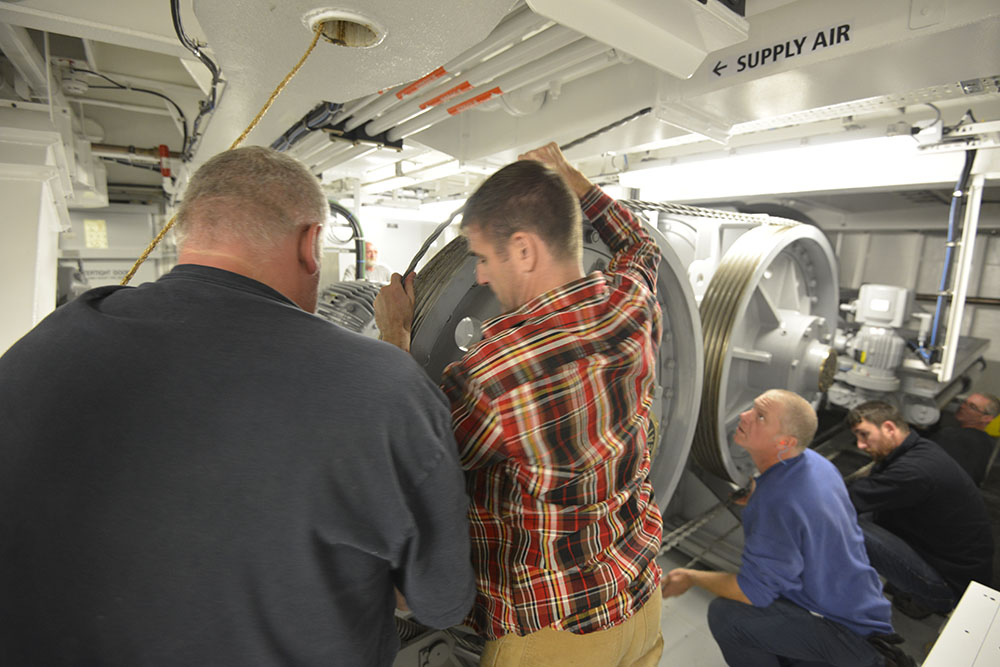
It took a team to thread the 9/16" trawl wire onto the traction drive in the winch room belowdecks. (Photo by Ken Kostel, Woods Hole Oceanographic Institution)
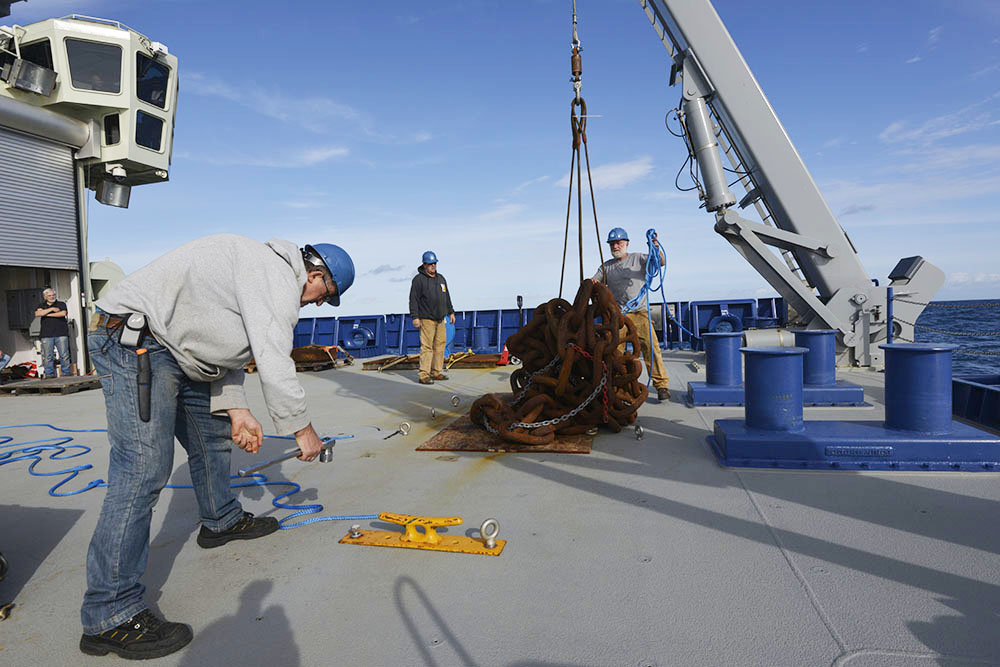
Crew of Neil Armstrong test the 9/16" trawl wire on the A-frame with 4,700 pounds of chain. (Photo by Ken Kostel, Woods Hole Oceanographic Institution)
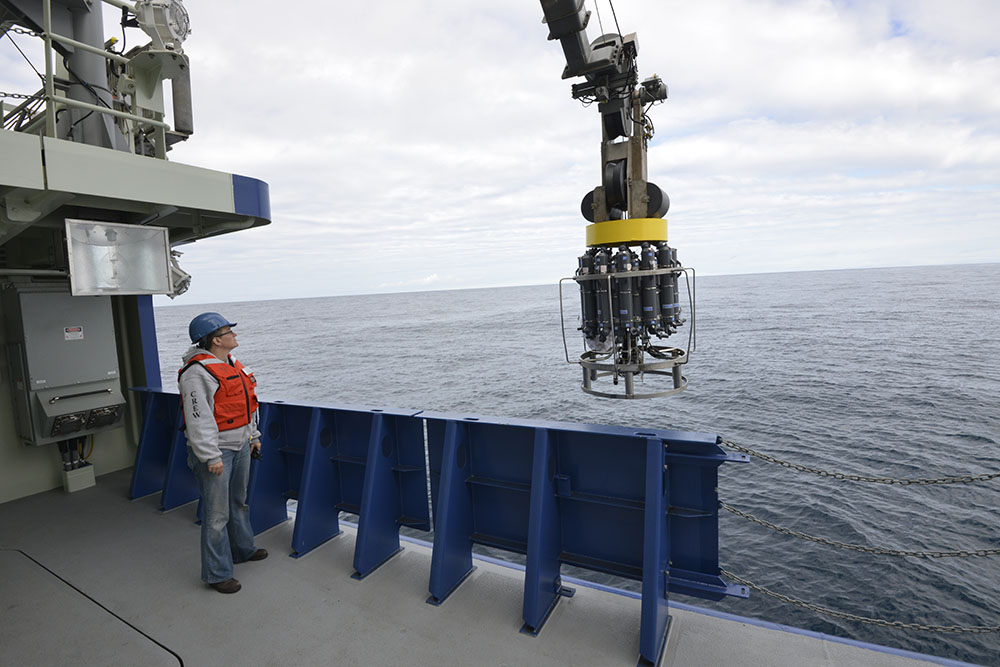
Shipboard Scientific Services Group technician Amy Simoneau watches the first CTD cast from Neil Armstrong. (Photo by Ken Kostel, Woods Hole Oceanographic Institution)
There are two things to know about winches, cranes, and wires: they are very complex and they are crucial to this ship (and to any oceanographic research vessel) accomplishing its mission. Day 3 of the transit to San Francisco began a series of tests that, if all goes well, should finish today and that constitute the main objective for this part of our trip.
First, a bit of nomenclature. Any of the wires that have copper or optical fibers at their core, giving them the capability to transmit data and power are called cables; any of the wires that are merely braided strands of metal are called wires. For simplicity, I’ll use the word wire to mean either type. There are 10 kilometers (6 miles) of on each winch drum the Neil Armstrong.
This is the first time the wires on each of the four winch drums has been run out, making it a crucial time in assessing the ship’s ability to support science. Two of the wires (one 3/8″ wire and one .322 cable) can be threaded onto each of two cranes on the starboard side. These are actually not cranes, but “knucklebooms” that unfold from the side of the ship like gray praying mantis arms to lower instruments into the water, ideally with minimal tending by deck crew. Just to add to the complexity of the operation, one of the winches is also able to compensate for the motion of the ship, so that anything hanging from it will remain relatively stationary in the water or can be brought up at a constant speed.
Under the rear deck of the ship, there is a large traction winch with two drums of wire (one 9/16″ wire, one .681 cable) that can be threaded up to the large A-frame on the stern. These are used for towing and lifting heavy loads, in the case of the 9/16″, or, with the .681 cable, to operate ROVs like Jason, by transmitting power, control signals, and even high-definition video along the length of the cable.
The complexity comes in winding and unwinding these drums in a controlled manner and under heavy loads. There is a severe sort of beauty to the precision with which the winches were designed and built—in particular with which something called the level wind was built. As the winch drum turns, the level wind places each strand of wire beside the one that came the turn before it and in between the two turns directly beneath it. Without the level wind, that ordered simplicity would be replaced by an over-wrap, or worse, a horrifying tangled mess called a wuzzle—something that can damage the wire by crimping or crushing it and that has been known to end a cruise prematurely.
To do its job, the level wind has to account for the diameter and type of wire, the number of layers already on the drum and the number of turns on the current layer. These winches have a level wind that is both electronically and mechanically controlled. The software controlling the level wind is hidden from sight, but the mechanical part of the level wind, something called a diamond screw, is laid bare. It is a massive, precision-machined shaft that turns slowly with the drum to keep the winding head (and wire) in just the right position at all times. One tiny deviation forms the nucleus of a wuzzle.
That’s the complex part. Now for the importance of these machines. Quite simply, we could not do ocean science without them. Any research ship can only move over the surface; we need other instruments to help us look into the depths. Some of those are (or soon will be) mounted to the bottom of the hull: sonars and current profilers and the like. But many scientists come on board eager to put things in the water that take samples, gather data, or explore features like hydrothermal vents. For that, we need winches, cranes and wires (or cables). And we need them to be reliable, well maintained, and ready to work turn after turn and time after time. Hence the care with which these are being tested, observed, and assessed.
One of the most common instruments that will be going over the starboard side is the CTD (conductivity, temperature, depth) rosette, which measures those basic properties of the water and is equipped with two dozen 10-liter bottles that a technician can close from the surface to capture water sample at specific depths. This is considered the bread-and-butter of ocean science. Today, in our last test, we lowered the CTD almost to the bottom, a little over 4000 meters (2.5 miles).
It’s later now and the CTD is on deck. When it came to the surface, it attracted the attention of some passing dolphins. The technicians still have to look at the data and assess how well the winches operated and the crew has to discuss how to fine-tune their choreography on deck with the new cranes, but overall things went well. The cranes might be fancier and the wires and winches shiny and new, but this crew has worked with heavy machinery like this for years.
Every cast brought a little more light to the question of how well the Neil Armstrong would be able to that most basic task of putting something over the side and bringing it back again. (The answer: It will do just fine.) There are some changes that will need to be made in the upcoming yard period to accommodate different instrument packages, but with that final deployment today, carrying a CTD within a few dozen feet of the seafloor and back, Neil Armstrong made one thing clear. This is a research vessel and it is equipped to bring knowledge to the surface.
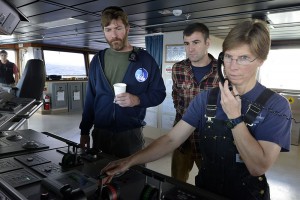
Captain Kent Sheasley, relief chief mate Derek Bergeron, and second mate Jen Hickey (left to right) learn the ins and outs of their new ship so more scientists can get out on the ocean. (Photo by Ken Kostel, Woods Hole Oceanographic Institution)
Building a ship like Neil Armstrong and its sister ship Sally Ride is not cheap, but compared to what they will give us over the next 40 or 50 years in terms of knowledge about the ocean, they will almost certainly pay for themselves many times over.
The ocean sustains us. It makes Earth livable and makes life as we know it possible. It harbors the greatest diversity and abundance of life on our planet and it is the single largest living space that we know of. Anywhere. Oceans on one of the moons of Jupiter or Saturn may eventually prove to be larger or richer and more biodiverse, but right now the ocean that covers more than two-thirds of Earth is the only one we know of in the solar system—and it is the one that defines our planet and our existence.
When you look out over the oce an, that unbroken horizon and the relative sameness of that surface hide a complex world that borders on the fanciful. The seafloor is a vast terrain more spectacular than almost anything on dry land. There are peaks higher than Everest, mountain ranges longer and more rugged than the Andes, fissures deeper and more awe-inspiring than the Grand Canyon, and plains that could swallow the Sahara.
an, that unbroken horizon and the relative sameness of that surface hide a complex world that borders on the fanciful. The seafloor is a vast terrain more spectacular than almost anything on dry land. There are peaks higher than Everest, mountain ranges longer and more rugged than the Andes, fissures deeper and more awe-inspiring than the Grand Canyon, and plains that could swallow the Sahara.
But in many respects those are tourist attractions (with a nod to the geophysicists and the forces that created the topography.) The ocean is also teeming with life, from shallow coral reefs to the sediments beneath the deepest trenches. Some of it provides us with food, and for nearly one billion people on the planet – many of whom live in developing countries – seafood is a primary source of their daily protein. Smaller and less charismatic organisms, marine algae, produce as much or more oxygen than all of the forests on land combined. Think of them the next time you take a breath. Marine microbes, many of which have yet to be named or understood and some of which hold the potential for novel materials or life-saving drugs, are more abundant than stars in the known universe.
And yet, for all its importance to us and to every other living thing we know of and to almost every planetary system that helps make Earth livable, we know remarkably little about what goes on at or beneath the ocean surface, let alone how human activity is beginning to alter the way it works. That’s not to say that we don’t know anything. In fact, we know quite a lot, which is a testament to what can happen when curious, motivated scientists and engineers have the opportunity to go to sea. But research ships are scarce and ship time for scientists woefully short to fill the gap between what we know and what we need to know. And that gap only seems to widen every time we learn something new.
One thing that has become abundantly clear in recent years is that the ocean is changing. Humans have long seen the ocean as virtually limitless and untouchable and so have used it as a dumping ground for waste and refuse. The impacts that resulted were relatively confined, but now the changes we see span the globe and echo throughout the water column. Surface water is getting warmer as a direct result of humans burning more fossil fuels and pumping more heat-trapping carbon dioxide into the atmosphere. As a result, individual species and entire ecosystems are rearranging themselves, not always successfully. Precipitation patterns and other elements of the climate that dictated how and where humans settled on land are also reshuffling in response to the physical changes we’re forcing on the ocean. And now the ocean’s very chemistry is also changing, growing more acidic, again as a direct result of the increase in carbon dioxide in the atmosphere and with any number of potential impacts on marine ecosystems—none of them good.
To study the ocean—to understand how it works, how we are changing it, and how those changes are likely to affect us in turn—we need ships like Armstrong and people to go to sea on them. We need to put our instruments in the water, take samples, make measurements, and to do it all again next year. Or next season. Or tomorrow.
That is why we build ships like this one. And why we need more of them.
As this entry is being posted, we are leaving the dock in Anacortes. There is no science on the cruise. Instead, the focus of this trip is the ship itself. The crew and back-up crew will use the time to get used to the ship’s systems and to working together again after almost a year on shore. We will also be running the winches out and in again under load to make sure they are operating correctly (more on this later).
In 2010, when the U.S. Navy formally awarded WHOI operation of what was then known as AGOR 27, this ship was just a set of drawings. Then construction began in Anacortes and it slowly assumed a ship-like shape. Then it got a name: Neil Armstrong. And finally, in 2014, the hull first touched water. Today, it heads to open water for the first time. Today, it becomes an ocean-going vessel.
A few have questioned the logic of naming a research vessel after an astronaut. Let’s put those questions to rest. In addition to being the first man to walk on the moon, Armstrong was also a Navy pilot—and the U.S. Navy owns this ship. But they named the sister ship after the shuttle astronaut Sally Ride, so the reason behind the choice is more complex than just a desire to honor one of their own.
Both Armstrong and Ride chose their paths partly out of a desire to challenge themselves, to explore, to learn, and to serve as an example to anyone who might choose to follow. There isn’t much more that gets at the heart of what drives the scientists and students who look to the ocean for answers to some very fundamental questions about how our planet works and how it is able to sustain life.
For the next half century, this ship will be the base from which generations of researchers will work to expand our knowledge about the ocean. There will almost certainly be advances over the coming decades that will allow scientists to do more of their work from shore. Autonomous vehicles, large mooring arrays, and new satellite-based sensors s are becoming more sophisticated and commonplace every year. It’s also expensive and occasionally dangerous to go to sea, but the rewards, in the form of a better appreciation for our planet and our place on it, are invaluable. But as Armstrong taught us with that first small step off the ladder onto the surface of the moon, there is very often no replacement for a human presence at the edge of what is known and a human voice to tell us what is there.
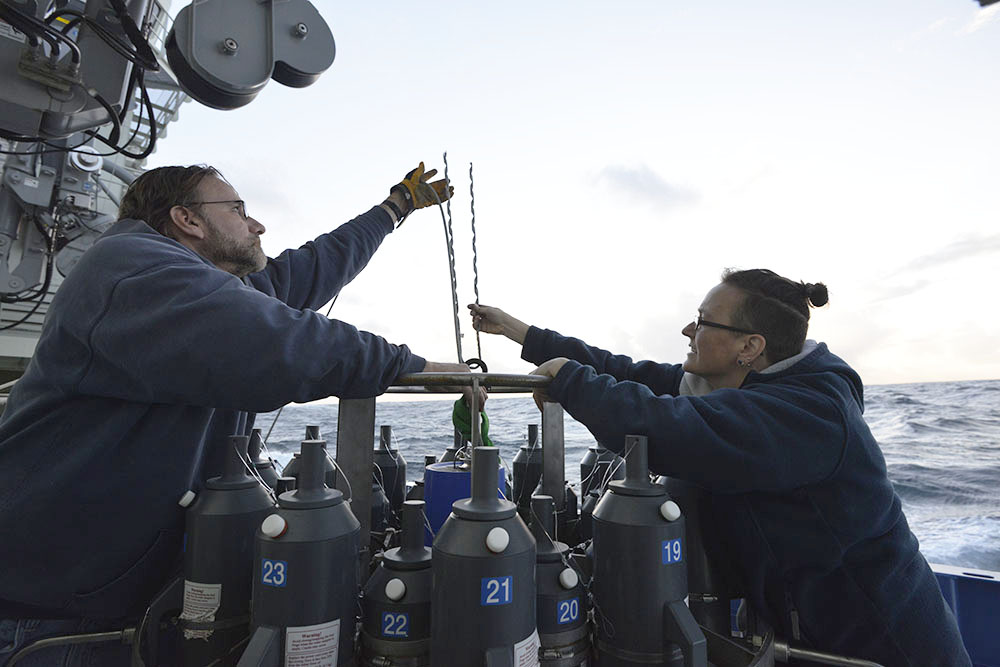
Technicians Chris Griner and Amy Simoneau prepare the ship's CTD for winch tests in deep water. (Photo by Ken Kostel, Woods Hole Oceanographic Institution)
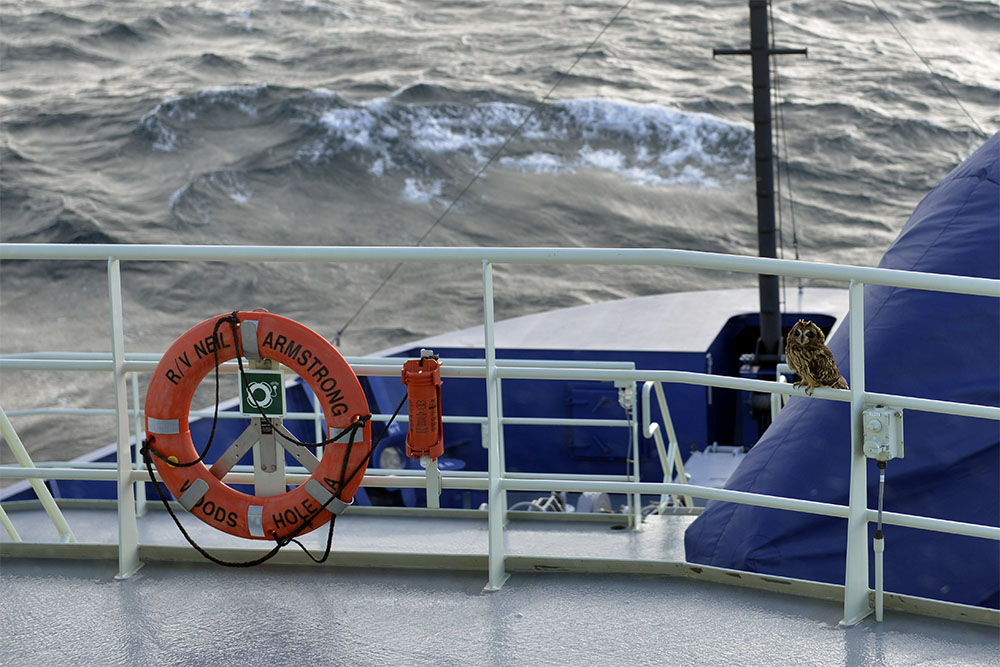
Knorr has had a long history of owls hitching rides far from shore—a tradition that Armstrong continued on its second day from port. (Photo by Ken Kostel, Woods Hole Oceanographic Institution)
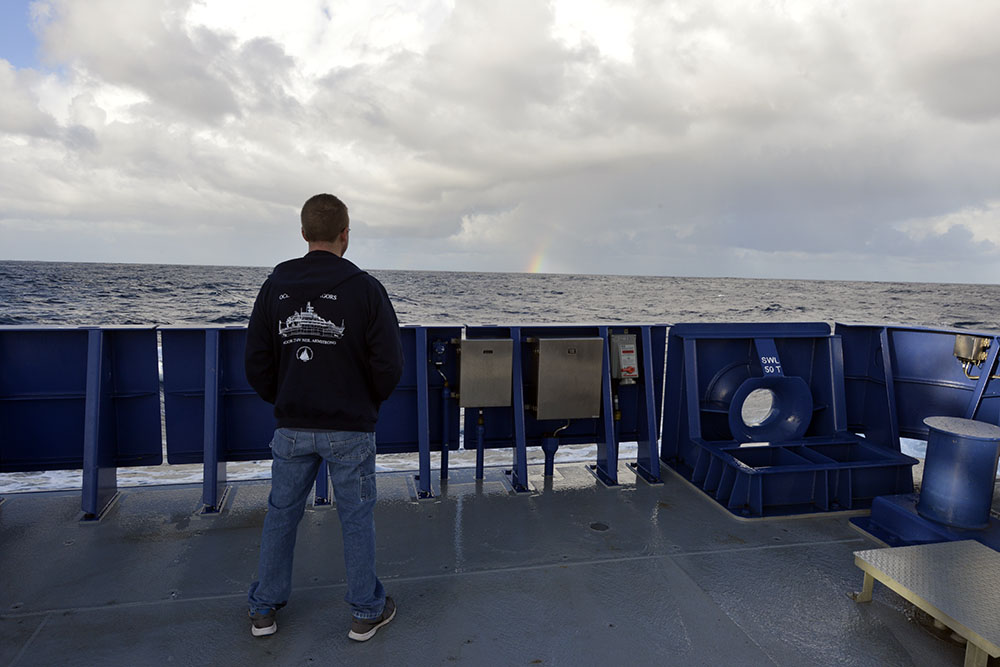
Day two brought better weather, something the crew never seems to tire of. (Photo by Ken Kostel, Woods Hole Oceanographic Institution)

The first day out from Anacortes gave the crew a chance to learn how their new home took the weather. (Photo by Ken Kostel, Woods Hole Oceanographic Institution)
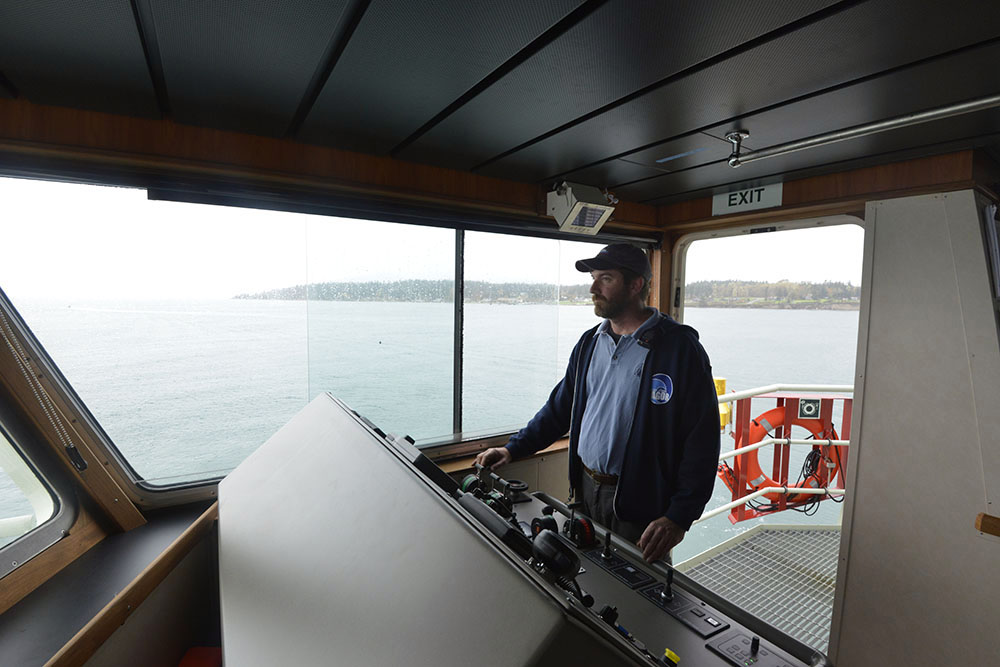
Armstrong captain Kent Sheasley eases Armstrong away from shore. (Photo by Ken Kostel, Woods Hole Oceanographic Institution)
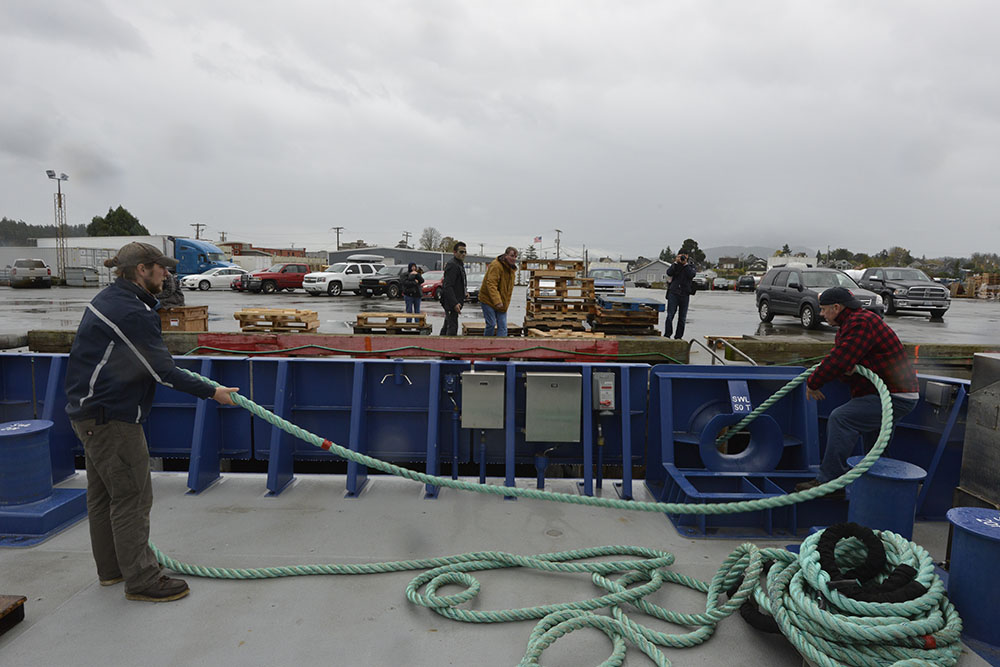
Third mate Josh Woodrow and WHOI port engineer Hank Ayers cast off with a little help from a group of Anacortes residents. (Photo by Ken Kostel, Woods Hole Oceanographic Institution)
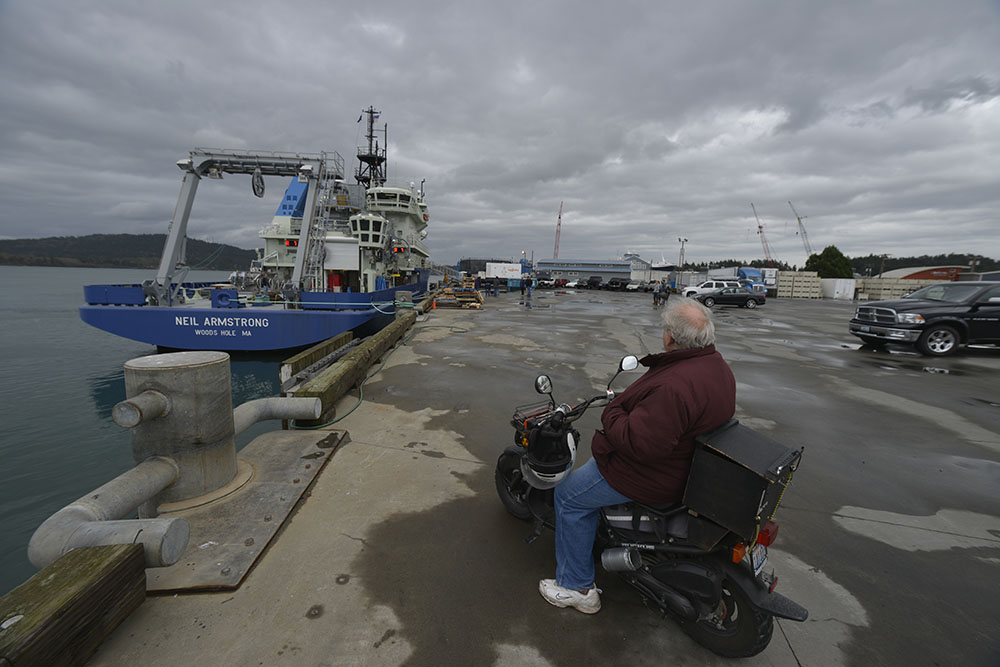
Several residents from Anacortes came down to the dock to see Neil Armstrong depart. (Photo by Ken Kostel, Woods Hole Oceanographic Institution)
Departure from Anacortes, Wash., marked the beginning of Neil Armstrong’s maiden voyage and, for the crew, a return to the rhythms of life at sea, plus a surprise guest.
The research vessel Neil Armstrong is named for the American hero whose “one small step” provided humanity with a new perspective on our planet and is operated by the Woods Hole Oceanographic Institution. Read more »
Funding for R/V Neil Armstrong comes from the Office of Naval Research, the National Science Foundation, and the National Atmospheric and Oceanic Administration.
 WHOI is the world's leading non-profit oceanographic
research organization. Our mission is to explore and understand the ocean and to
educate scientists, students, decision-makers, and the public.
WHOI is the world's leading non-profit oceanographic
research organization. Our mission is to explore and understand the ocean and to
educate scientists, students, decision-makers, and the public.
